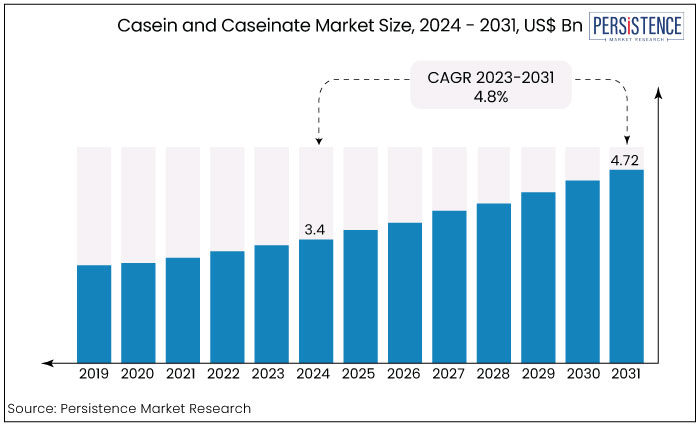Industry: Food and Beverages
Published Date: October-2024
Format: PPT*, PDF, EXCEL
Delivery Timelines: Contact Sales
Number of Pages: 175
Report ID: PMRREP5873
The casein and caseinate market is estimated to increase from US$ 3.4 Bn in 2024 to US$ 4.72 Bn by 2031. It is projected to record a CAGR of 4.8% during the forecast period from 2024 to 2031. The global market is primarily driven by increasing demand for protein-rich products, diverse applications, and growth in emerging markets. Even though the competition from plant-based alternatives is set to remain strong, demand is expected to be considerable by 2031.
The Council for Responsible Nutrition (CRN), for instance, states that in 2021 alone, approximately 80% of adults above the age of 18 in the U.S. consumed dietary supplements. The numbers are estimated to skyrocket in the next ten years, thereby creating new opportunities for casein and caseinate vendors.

Key Highlights of the Market
|
Market Attributes |
Key Insights |
|
Casein and Caseinate Market Size (2024E) |
US$ 3.4 Bn |
|
Projected Market Value (2031F) |
US$ 4.72 Bn |
|
Global Market Growth Rate (CAGR 2024 to 2031) |
4.8% |
|
Historical Market Growth Rate (CAGR 2019 to 2023) |
4.1% |
|
Region |
Market Share in 2024 |
|
North America |
35% |
The rising costs of primary materials in North America influence the prices of casein and caseinates. The market's expansion is being driven by the adoption of casein protein for sports nutrition in developed economies like the U.S. and Canada.
Demand for acid casein for industrial applications as well as need for affordable, high-quality, and edible casein facilitates the market's expansion in developed economies. North America is being significantly influenced by the increasing prominence of nutritional enrichment in food and beverage products. It is mainly pushed by the growing awareness of the importance of maintaining a healthy lifestyle.

The demand for dairy ingredients, such as casein and caseinates, is rising due to their multifunctionality in various end-user industries, including bakery, confectionery, nutritional beverage, poultry, and dairy. Consequently, firms have been introducing new products to capitalize on the emerging opportunities throughout the region.
|
Category |
Market Share in 2024 |
|
Casein Type - Acid Casein |
52% |
Based on casein type, the market is bifurcated into acid and rennet casein, where the acid segment dominates the market. Acid casein is anticipated to hold a substantial market share of 52% in 2024 due to its functional properties, which include the capacity to form stable gels, emulsify lipids, and enhance the texture of food products.
Acid casein is a versatile ingredient extensively used in the food industry. It is mainly incorporated in the production of cheese, baked goods, processed meats, and confectionery.
Acid casein is often considered an ideal choice for those manufacturers seeking an inexpensive protein source. The product is relatively simple to use and cost-effective compared to its counterparts.
|
Category |
Market Share in 2024 |
|
Caseinate Type - Calcium |
48% |
Based on caseinate type, the market is classified into calcium, potassium, and sodium, where the calcium segment dominates worldwide. Calcium caseinates are suitable for diverse food applications due to their functional properties.
The sensory properties and quality of food products can be enhanced by their use as emulsifiers, thickeners, stabilizers, and texturizers. This adaptability allows manufacturers to integrate calcium caseinates into diverse foods and beverages, thereby boosting sales.
Calcium caseinates are frequently employed in sports nutrition products due to their sluggish digestion rate. They generate a consistent discharge of amino acids, including calcium, to facilitate muscle repair and expansion after physical activity. Protein bars, smoothies, and other supplement providers are increasingly incorporating calcium caseinates, which has resulted in a rise in their sales.
Casein and caseinates are in high demand from various industrial applications, such as plastic, fiber, paint, paper, adhesive, textiles, and the food and beverage industry. About 3.3% of the protein in cow's milk is composed of large casein aggregates, with 80% of the protein being casein.
Colors, glues, glossy materials, and sealants are manufactured by the chemical industry using acid casein, which is precipitated primarily through hydrochloric acid. The confectionery segment in the food and beverage industry is experiencing a surge in popularity due to the significant functional benefits of caseinates. Baked products incorporate caseinate ingredients, including cheesecakes, puddings, frostings, and whipped toppings.
The cosmetics and personal care industry is experiencing a surge in the use of casein as emulsifying agents and hair and skin conditioning agents, creating new opportunities for manufacturers to expand their shares. Dietary supplements have extensively employed casein and caseinates. Hence, demand for nutritional supplements is anticipated to drive the market under investigation.
The casein and caseinate industry experienced steady growth pre-2023, driven by rising demand for protein-rich foods and beverages, especially in the nutrition and sports supplement industries. Caseinates, derived from casein protein found in milk, are highly valued for their slow-digesting properties, making them a popular ingredient in meal replacements, infant formulas, and protein bars.
The growing health consciousness among consumers and the increasing awareness of the benefits of casein protein in muscle recovery and weight management further boosted demand. The dairy industry’s focus on product innovation, such as lactose-free and fortified dairy products, supported the casein market’s expansion.
Post-2024, the casein and caseinate industry will likely witness accelerated growth due to several factors. The expanding demand for functional and fortified foods, particularly in emerging markets, will significantly drive expansion.
The high popularity of plant-based and alternative protein sources could present certain challenges, but dairy-based caseinates are likely to retain their stronghold due to their superior functional properties. Innovations in dairy processing technologies and new food, pharmaceuticals, and cosmetics applications are expected to unlock novel growth opportunities. Analysts project a robust CAGR, indicating sustained momentum in the years following 2024.
Rising Adoption of High-protein Diets and Supplements to Fuel Sales
One of the primary drivers of the casein and caseinate industry is the increasing consumer preference for high-protein diets. As awareness of the benefits of protein-rich foods for muscle development, weight management, and health rises, demand for high-quality protein sources like casein has surged.
Caseinates, known for their slow digestion and sustained release of amino acids, are especially popular among athletes, fitness enthusiasts, and individuals seeking effective weight management solutions. In sports nutrition, casein-based products are favoured for post-workout recovery and muscle maintenance due to their long-lasting nourishment.
The growing focus on health and wellness, combined with an expanding consumer base interested in fitness and nutrition, has significantly boosted demand for casein and caseinate products in various forms, such as protein powders, bars, and meal replacements.
Booming Infant Nutrition and Clinical Nutrition Markets to Propel Demand
Another significant driver for the casein and caseinate market is their increasing use in infant and clinical nutrition products. Caseinates are often included in infant formulas due to their high-quality protein content and ability to mimic human breast milk's slow-digesting properties.
As global birth rates stabilize and demand for premium infant nutrition products rises, the casein market benefits from this trend. Similarly, caseinates are gaining popularity in clinical nutrition and are set to be used in products designed for patients recovering from illness, surgery, or malnutrition.
The proteins provide essential nutrients in a form that can be easily digested and absorbed, making them ideal for medical applications. As the population ages and healthcare firms increasingly focus on nutrition, demand for caseinates in clinical and specialized nutrition markets is set to surge steadily.
Growing Popularity of Plant-based Proteins to Hamper Sales
One of the key restraints for the casein and caseinate market is the rising popularity of plant-based proteins. With increasing concerns over sustainability, animal welfare, and lactose intolerance, several consumers are shifting toward plant-based alternatives like soy, pea, and almond protein. These plant-based proteins are gaining traction, particularly across health-conscious and vegan communities.
Dairy-based proteins, including casein and caseinates, face significant competition from these alternatives. Moreover, the growing trend toward plant-based diets is being driven by younger consumers and environmental considerations, further limiting casein's growth potential in certain segments. This trend could reduce demand for dairy-derived proteins, slowing sales of casein and caseinate products.
Fluctuating Milk Prices and Supply Chain Issues May Create Hindrances
Another key restraint for the casein and caseinate industry is the volatility of milk prices and supply chain challenges. Since casein is derived from milk, fluctuations in milk production caused by weather conditions, feed prices, and governmental policies can directly impact the cost of casein production.
High milk prices make caseinates expensive, reducing demand from cost-sensitive industries like food processing and animal feed. Additionally, disruptions in the dairy supply chain, whether due to logistical challenges or regulatory restrictions, can create uncertainties in the availability of raw materials, further affecting market stability. These factors contribute to pricing volatility and can restrict the casein and caseinate market growth, especially in regions heavily dependent on dairy imports.
Surging Demand for Functional and Fortified Foods to Create Opportunities
One of the most transformative opportunities in the casein and caseinate industry lies in the increasing demand for functional and fortified foods. As consumers become more health-conscious, they seek food products that satisfy their nutritional needs and offer additional health benefits. Caseinates, known for their high protein content and functional properties like emulsification and texture enhancement, are ideal for creating value-added products.
Dairy products, protein-enriched snacks, and beverages are prime categories where caseinates can enhance nutritional content without compromising taste or texture. This trend toward functional foods as well as rising interest in clean labels and high-quality ingredients presents significant opportunities for casein producers to cater to a growing market for health-focused foods.
Increased Use in Clinical and Medical Nutrition to Open Door to Success
Using caseinates in clinical and medical nutrition represents another transformative opportunity for key companies. As the global population ages and healthcare systems focus on preventative care, there is an increasing demand for specialized nutrition products designed to support recovery and health. Caseinates are particularly suitable for clinical nutrition because of their high-quality, slow-digesting protein that supports muscle maintenance and repair.
The proteins are commonly used in medical supplements, meal replacements, and therapeutic foods aimed at patients with specific nutritional needs, such as those recovering from surgery or illness. The increasing awareness of the role of nutrition in patient recovery, along with advances in medical nutrition products, provides a promising growth avenue for the casein market.
The global market's competitive landscape is marked by several global and regional players, with key participants, including Fonterra Co-operative Group, Glanbia Nutritionals, Kerry Group, and Arla Foods Ingredients.
Major companies leverage their vast dairy supply chains and expertise in protein manufacturing to produce high-quality caseinates for various applications, such as food, beverages, and clinical nutrition. The highly competitive market focuses on product innovation, sustainability, and strategic partnerships.
Companies are investing in research and development activities to improve the functional properties of caseinates and meet the growing demand for clean-label, protein-enriched products. The market sees competition from plant-based protein producers, thereby intensifying the focus on differentiation strategies.
Recent Industry Developments
|
Attributes |
Details |
|
Forecast Period |
2024 to 2031 |
|
Historical Data Available for |
2019 to 2023 |
|
Market Analysis |
US$ Billion for Value |
|
Key Regions Covered |
|
|
Key Market Segments Covered |
|
|
Key Companies Profiled in the Report |
|
|
Report Coverage |
|
|
Customization & Pricing |
Available upon request |
By Casein Type
By Caseinate Type
By Application
By Region
To know more about delivery timeline for this report Contact Sales

The market is estimated to be valued at US$ 4.72 Bn by 2031.
The market is projected to exhibit a CAGR of 4.8% over the forecast period.
Fonterra Co-operative Group Limited, Groupe Lactalis, and Arla Foods AMBA are few of the key players.
North America is a dominant regional market for casein and caseinate.
Food & beverages leads the market with major market share.